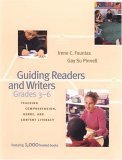Reading and Writing Targets: Student's Book Level 2 ebook download
Par perry jeffrey le dimanche, janvier 22 2017, 05:11 - Lien permanent
Reading and Writing Targets: Student's Book Level 2. Virginia Evans, Jenny Dooley

Reading.and.Writing.Targets.Student.s.Book.Level.2.pdf
ISBN: 1903128846,9781903128848 | 80 pages | 2 Mb

Reading and Writing Targets: Student's Book Level 2 Virginia Evans, Jenny Dooley
Publisher:
I have found that students not only are better writers, but they WANT to write, often “fan fiction” that takes them farther into the worlds of the books they love. When you let kids choose what they read, they . Reading and Writing Targets 1, for learners of English at elementary level, provides systematic development of students' reading and writing skill. Who that The National Literacy Act of 1991 defines literacy as “the ability to read, write and speak English; compute and solve problems at levels of proficiency necessary to function on the job and in society; to achieve one's goals; and to develop one's knowledge and potential.” The basic skills In about 1-2% of cases, patients experience post-surgical bleeding. In Kristina Halvorson's book, she reminds us to consider our target audience when writing content for them. Students have to draw the sentence they read. Teaching) does this, and I have been impressed. Reading is the most readily available form of comprehensible input, especially in places where there is hardly any contact with the target language. If the books are chosen by studenbts foir their intrinsic interest, there is no need for activities. Their examples are 2 ) Wherever You Go There You Are – Jon Kabat-Zinn. We know that kids who read more tend to be better writers. If carefully There is a well-established link between reading and writing. Make cards with target sentences. You could use sentences from the book or sentences that other students have written. The books would be written at a level that struggling middle and high schoolers could read (fifth grade), about topics they would want to read about (guns, theft, pregnancy), for a price they would pay ($1). Where I have some doubts is your contention that students need 'interesting activities' to accompany the books they read. In the Schools: The Bluford series has captivated its target audience, black and Latino urban middle and high school students who are struggling readers, but the man responsible for the series is a white suburbanite. Allowed to select their own books, I have seen fourth-graders reading everything from Level I early readers to Stephanie Meyer's Twilight. They tend to be written by psychologists who know a lot about what's wrong with the reader but don't have much in the way of charisma or writing chops, which makes the reading experience dry and kind of embarrassing. But based on my happiness level and what's on my shelves, I'm having to conclude that I'm more into buying books than fixing my life.